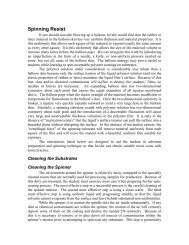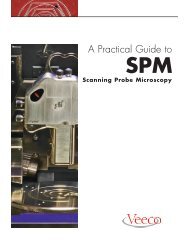DNA Fingerprinting Lesson Plan
DNA Fingerprinting Lesson Plan
DNA Fingerprinting Lesson Plan
You also want an ePaper? Increase the reach of your titles
YUMPU automatically turns print PDFs into web optimized ePapers that Google loves.
<strong>DNA</strong> Analysis<br />
Gel electrophoresis is a technique that scientists use to "measure" the size of <strong>DNA</strong> fragments. <strong>DNA</strong><br />
samples are first tagged with a dye, and then injected near one edge of an agarose gel. An electric<br />
current is then applied, which pulls the <strong>DNA</strong> material through the gel. Smaller fragments travel farther<br />
through the gel in a given time, which can then be detected thanks to the dye. A reference sample of<br />
known material is always included, to set a scale for the results.<br />
Figure 1 - Typical electrophoresis gel<br />
Whenever a cell replicates itself, all of the contents of the cell must be duplicated, including the <strong>DNA</strong><br />
within the cell. The mechanism by which this happens starts with unwinding and then separating the<br />
two strands of <strong>DNA</strong> from their initial double helix configuration. Each single strand then grows a<br />
complementary mate through a polymerization reaction controlled by the biological chemical<br />
polymerase. This polymerization reaction is termed the polymerase chain reaction, PCR. The<br />
original strand serves as a template to ensure that only a specific matching strand of <strong>DNA</strong> gets created,<br />
in an example of self-assembly.<br />
Within the laboratory scientists can use the polymerase chain reaction in a slightly different form in<br />
order to duplicate ( amplify ) a specifically chosen section of <strong>DNA</strong> for further analysis. First the <strong>DNA</strong> is<br />
heated to completely unwind and separate the two strands. Then primers are added onto the <strong>DNA</strong><br />
strands in specific locations ( using self-assembly ) as starting points for the polymerization. Finally the<br />
polymerase chain reaction is used to grow duplicate strands on each of the two original single strands.<br />
This procedure is then repeated for 20 to 30 cycles, yielding millions to billions of copies through the<br />
power of exponential increase. Careful selection of the original primers limits the duplication process to<br />
only a short specific section of the original <strong>DNA</strong>. PCR can be applied to samples as small as a single<br />
molecule, and even to degraded <strong>DNA</strong> that may have been broken down by time or harsh environments.<br />
Short Tandem Repeats, STRs, are short sections of <strong>DNA</strong> which repeat themselves a certain number<br />
of times. Where the repeat count differs among different individuals, it changes the length of the<br />
encompassing <strong>DNA</strong> fragment, which can be isolated with PCR and analyzed with gel electrophoresis.<br />
STR sections are frequently found within the 98% or so of "junk <strong>DNA</strong>" or "non-coding <strong>DNA</strong>" that does<br />
not contain the codes for any known genetic traits. The probability of two random individuals having<br />
identical STR counts at one particular <strong>DNA</strong> location ( loci ) is relatively large, but the chances of this<br />
happening at thirteen different loci ( the number used in U.S. forensics ) are so vanishingly small as to<br />
be nearly impossible. ( Identical twins, triplets, etc. have identical <strong>DNA</strong>, and the probability of<br />
laboratory error is higher than the statistical probability of random <strong>DNA</strong> matching. )

















